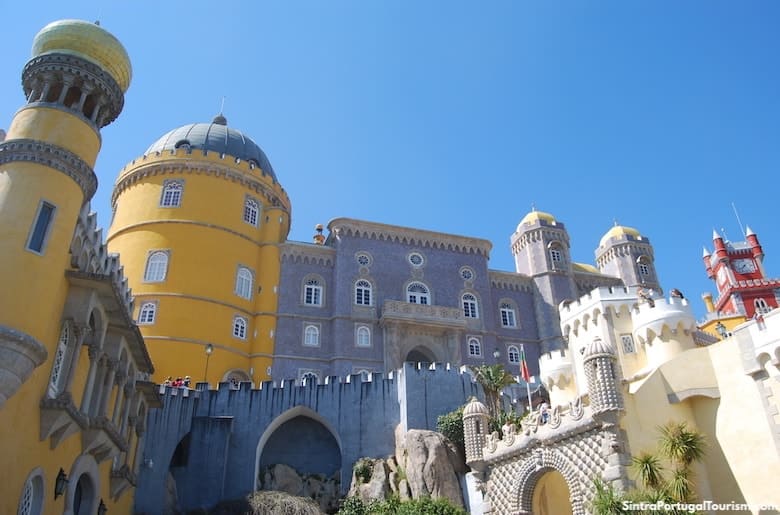
The exterior of the palace mixes several architectural styles
Pena Palace is something that not even Disney could dream of. It’s one of the world’s most spectacular palaces and one of Europe's most eclectic constructions. Resembling a fairytale castle, it was built in 1840 over an old monastery, which was incorporated into the new building (including a 16th-century chapel with a marble and alabaster altarpiece, and a Manueline cloister with decorative tiles from 1520).
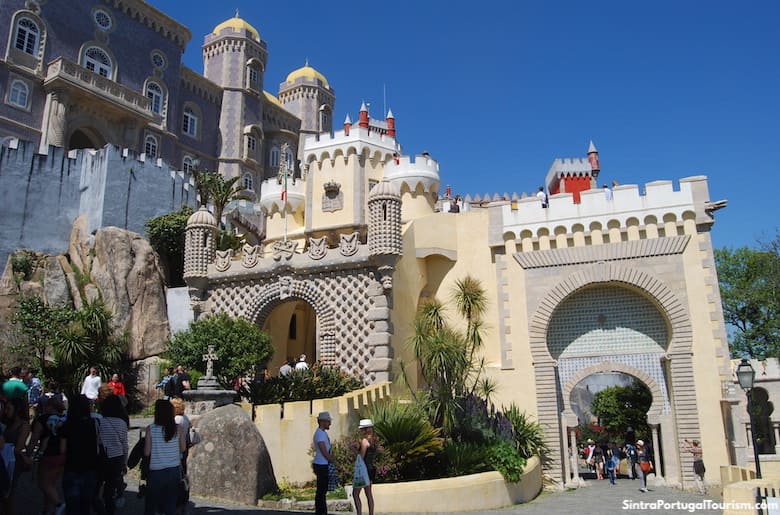
Entrance to Pena Palace
Located at the top of a mountain, it’s a fantasy palace mixing details inspired by the Gothic, Manueline, Moorish and Renaissance styles, creating one of the finest examples of European Romanticism. There are watchtowers of various shapes, one of the gateways is topped by the half-man half-fish Triton, and much of the interior (untouched since the last royals left in 1910) is decorated with oriental porcelain and European furniture. In the kitchen are displays of large cooking utensils used to prepare the royal banquets.
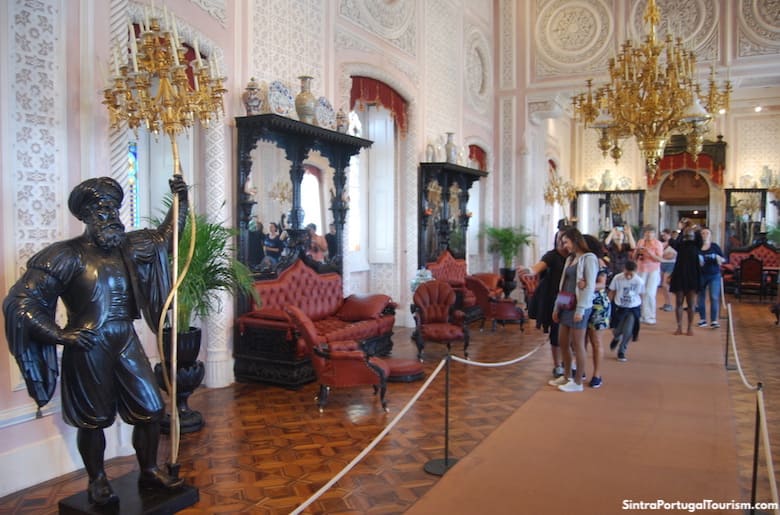
The "Great Hall" of the palace
Often compared to Germany's Bavarian castles, Pena is as symbolic to Portugal as Neuschwanstein is to Germany, but it actually predates that Bavarian icon by two decades, and is considered the first Romantic palace in Europe. It was planned by King Ferdinand, who also ordered the planting of Pena Park below it.
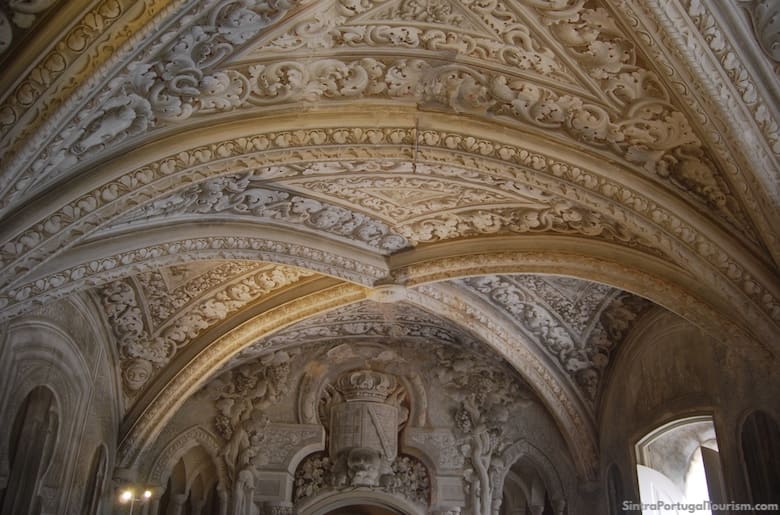
The "Visitor's Room" is covered with trompe-l'œil paintings, creating the optical illusion of sculpted walls and ceilings
The palace is comprised of two wings -- the one built over the former monastery (painted pink) and the new one (painted yellow), ringed by storybook watchtowers, battlements, and even a drawbridge. Fourteen monk cells were enlarged and given vaulted ceilings, and were where the royals lived when Pena became their summer residence. The dining room, which features a Manueline ceiling, is the former refectory. The old chapel has been left largely untouched (including the magnificent alabaster altarpiece from 1528), except for a stained glass window added in 1841, which depicts Vasco da Gama kneeling before King Manuel I, recalling the time when the king saw the explorer arrive back in Lisbon from India in 1502 from this mountaintop.
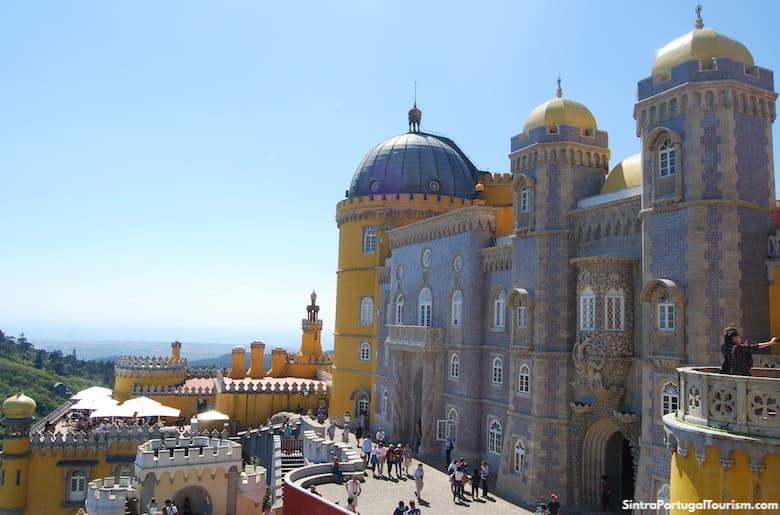
View from the "Queen's Terrace"
The art and furnishings that decorate the interior have been preserved to show what it was like to live like royalty between the end of the 1800s and the early 20th century. A curious piece is one of the earliest telephone exchanges in the Telephone Room, while in the king’s bathroom is Portugal’s first shower with hot water. Another highlight is the trompe-l’oeil on the ceiling and walls of the Arab Room, which creates the illusion of depth, and the stucco decoration of the Great Hall, which also features a golden bronze chandelier and four large sculptures of “Turks” holding candelabra with 25 candles each. In the impressive Indian Room is furniture brought from India and walls covered in oriental-style stucco ornamentation.
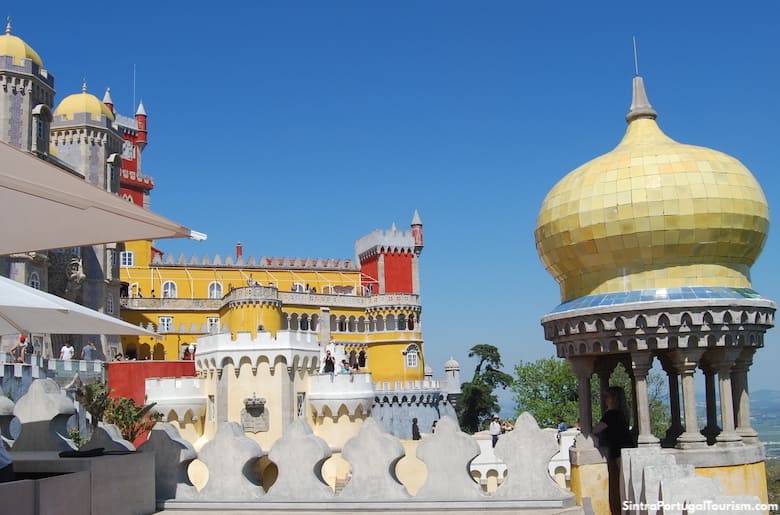
The palace has a café with outdoor seating on a terrace with a view
The interior gives access to the Queen’s Terrace, which is on the upper floor and overlooks Pena Park and the entrance gate to the palace. It’s here that many tourists stop for selfies, due to the magnificent view.
Outside, you’ll find that some features resemble those of other monuments in Portugal, such as the spiked gateway that resembles the Casa dos Bicos and Belém Tower in Lisbon, and a window clearly inspired by an iconic one in the Castle-Convent of Tomar.
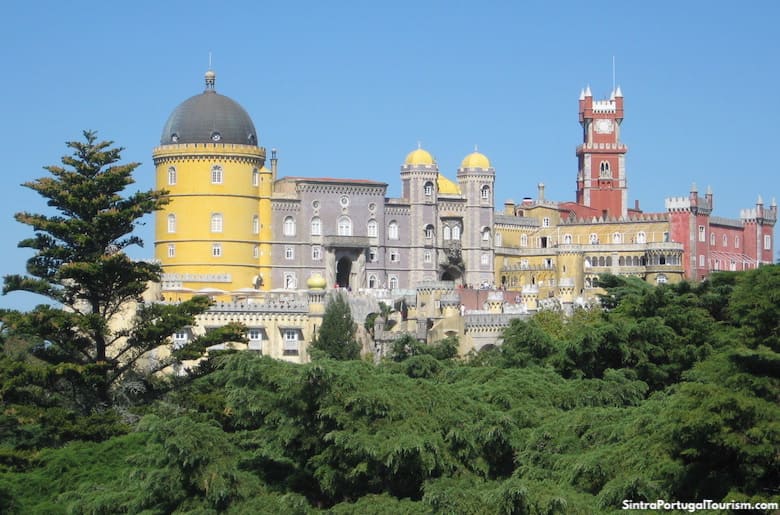
Pena Palace seen from Pena Park
A National Monument since 1910, Pena is part of Sintra’s “cultural landscape” that was classified by UNESCO as a World Heritage Site in 1995. In 2013 it became part of the Network of European Royal Residences and a CNN report considered it one of the world's most beautiful castles).
Visiting Pena Palace
Such a magnificent monument naturally attracts thousands of tourists. As a result, a visit may take almost half a day, including transportation to reach its mountaintop location, waiting in line for tickets, then waiting to access the interior, touring the rooms, and stopping to take the perfect photos. However, it is very much a must see, you just need some patience in the high season (April to September).
It opens at 9:30am, so make it your first stop in Sintra to avoid the larger crowds (often several tour buses at the same time) that tend to arrive by mid-morning. Continuing into Pena Park, you can spend most of the day here, but should also stop at the Moorish Castle, which is just a short walk down from the palace.
Admission and Tickets to Pena Palace
Admission to Pena Palace is €14 for adults and €12.50 for children between the ages of 6 and 17. That’s the “Palace+Park” ticket, which allows you to tour the interior, walk around the terraces outside, and explore Pena Park below. If you just want to get close to the monument and see it from the terrace outside by the gate, you may acquire a cheaper ticket (the “Park” ticket), of just €7.50 for adults and €6.50 for children, which is the admission to Pena Park alone. The Lisboa Card offers a 10% discount for both.
You can also save time by buying the tickets online here: Pena Palace and Park Tickets
Opens every day
How to Get to Pena Palace
It’s a demanding hour-long hike from the center of town up to the gate at the top of the mountain, so unless you’re fit, enjoying hiking, and have plenty of time to spare, you need to take a bus, which departs from outside the train station. For complete details, see the guide to the 434 bus.
Never drive up to the palace, as there is almost no parking, and navigating the narrow twisting roads of Sintra can be nerve-wracking.